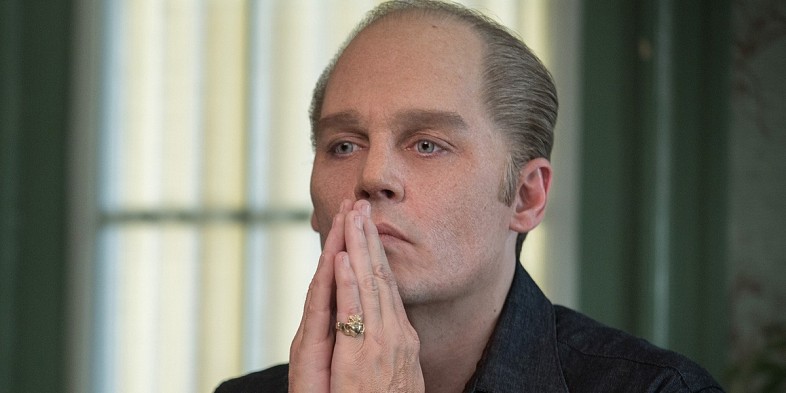
Having recently watched BLACK MASS, this year’s film starring an actor with a dramatic physical transformation, it was difficult not to think about this growing trend and its effectiveness.
BLACK MASS is a solid gangster film with good performances throughout, including what should be considered as Johnny Depp’s best performance, but the one thing everyone is talking about is how weird Depp looks. There was a similar discussion last year after Steve Carell’s performance in FOXCATCHER. It is interesting that this gets discussed more than the actual content of the film. It appears to be a trend that happens especially around awards season. Actors will become unrecognisable for the hope of Oscar glory, but does appearance matter more than performance?
Some argued that Carell could have been brilliant at playing John du Pont in FOXCATCHER, but the amount of prosthetic makeup he had on his face prevented him from being able to move it! There’s also the distraction factor; for the first half hour of both FOXCATCHER and BLACK MASS the thing on a lot of people’s minds is ‘Wow! They look so weird, so different!’ A lot of critics will say ‘Depp is unrecognisable in this role,’ but what do they mean? Do they mean he completely immerses himself in the role of James ‘Whitey’ Bulger, so much so that you forget he is an actor in a film? Or do they just mean that Johnny Depp doesn’t look like Johnny Depp?
Of course, there can be different uses of makeup like this; a lot of people remember Tom Cruise’s wonderful performance in TROPIC THUNDER (2008). His comedic role was emboldened with his comical appearance. The bald cap, the fat suit, and the disgusting hair on his hands (which was his idea) all contributed to a yuck factor for the character. Also, when you realised it was Cruise, that upped the hilarity. You could argue the use of prosthetic makeup here was successful because it was for a comedic purpose – his character was ridiculous and a parody, therefore his appearance should be too. Trying to make an actor wear heavy prosthetic makeup on their face for a serious and gritty role and then get the audience to believe it is sometimes a bit too much to ask.
Who can forget the over-use of prosthetic makeup in the Wachowskis’ CLOUD ATLAS (2012)? The film had a lot of problems but the biggest complaint and cause for tonal confusion was the makeup applied to the actors. The book itself was about the reincarnation of people throughout history and the survival of the human soul, and you can applaud the Wachowskis’ for even trying to put that on screen. The result however, was not worthy of praise; Hugo Weaving dressed as a female nurse, borderline racist scenes involving Jim Sturgess as a Japanese man, Doona Bae made to appear as a white woman in the 1700s. The whole thing was just too bizarre, and it appeared that the Wachowskis’ had not understood the book enough either – actors were portraying characters in different periods, but not the correct ones to match the other times – therefore the entire reincarnation theme was lost for the sake of comical makeup. It appeared as though they focused more time on the makeup than on making sure their script made sense.
Some filmmakers have tried to use this new method in a subtle and necessary manner. Rian Johnson’s LOOPER (2012) saw Joseph Gordon-Levitt adopt a fake nose and contact lenses in order to look more like Bruce Willis, who was playing his future self in the film. Doing this does make sense, it makes them look a bit more like each other and makes it plausible that Joseph Gordon-Levitt is the younger version of Bruce Willis. However, it was very distracting. There have been several films where two actors have played the same character at different ages, most recently X-MEN: DAYS OF FUTURE PAST (2014) where James McAvoy and Michael Fassbender play younger versions of Patrick Stewart and Ian McKellen. No one in that film had any facial prosthetics to make them look more like another actor, the facial structure of the actors has never been a major issue so long as they vaguely look like each other i.e. same colour of eyes and perhaps the same height.
A similar argument could be made against any physical change in actors. A lot of method actors lose or gain a lot of weight for certain roles. It could be argued that this is just as distracting as having extensive makeup. Admittedly, most of us were thinking about how unwell Christian Bale looked in THE MACHINIST (2004), how different Matthew McConaughey looked in DALLAS BUYERS CLUB (2014), and how unhealthy it was for Jared Leto to put on so much weight for CHAPTER 27 (2007). A good counter-argument is that all of these examples are that of natural changes; no prosthetics were used to change these actors, they all lost or gained weight over several months for their roles.
The difference between an actor bulking up a lot for a boxing film, like Robert De Niro in RAGING BULL (1980) and Joseph Gordon-Levitt wearing a fake nose is that we can instantly spot which is real and which is not. Although technology and prosthetic techniques have improved significantly in recent years, we can still tell what is not real. We cannot help but try to find the seam between the bald cap and Johnny Depp’s head, notice that Steve Carell can’t move his face, and that Halle Berry’s prosthetic cheeks are uneven and patchy in CLOUD ATLAS.
The really interesting thing about all of this is that this advance in technology means we could be in store for some great science fiction and horror characters. These are the genres where this form of makeup is most appropriate and will be appreciated. There have already been great examples of using extensive makeup for this use; Dave Bautista physically looked the same, but his skin design was fantastic in GUARDIANS OF THE GALAXY (2014). Some of the zombies in THE WALKING DEAD look fantastic and the prosthetics mean we have some of the coolest looking zombies ever on that show.
Overall, the use of facial prosthetics appears to divide critics. Some people think it is a useful tool to make an actor look more like the character they are portraying and a great example of how creative the film industry can be, others believe it is too distracting and ultimately unnecessary in certain films. Whatever your opinion, it seems like the trend is picking up and we may see more interesting examples in the future.
Are you a fan of the use of such extensive prosthetics? Share your thoughts below.






























